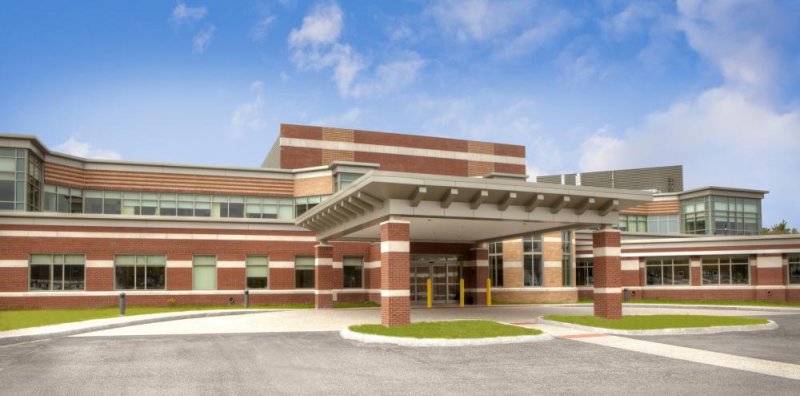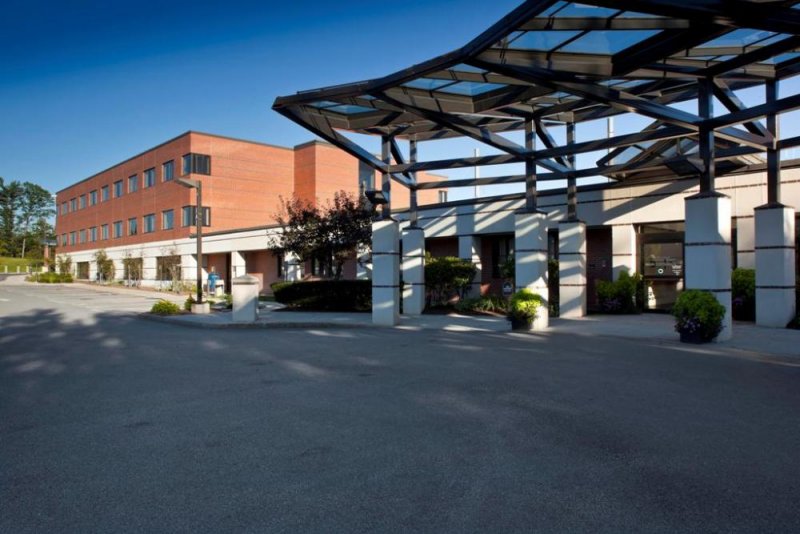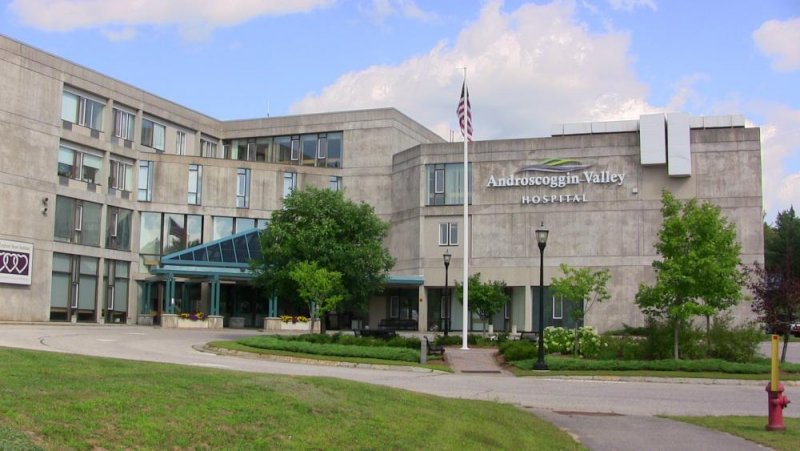 Huggins Hospital in Wolfeboro. (Courtesy of Higgins Hospital.)
Huggins Hospital in Wolfeboro. (Courtesy of Higgins Hospital.)
(Editor' Note: This story was updated at 7:20 a.m. on Sept. 28 to clarify a statement made by Michael Peterson of Androscoggin Valley Hospital.)
New Hampshire’s rural hospitals, which provide care to the sickest of the sick in the state, are struggling with their own financial health.
With soaring labor costs, supply issues, a tangle of reimbursement regulations to navigate and growing demand for services, the state’s non-urban hospitals are battling to stay in the black while still serving their communities.
Of NH’s 26 hospitals, 13 are considered rural and most of those are in the North Country.
The challenges faced by all hospitals in the state—such as recruiting and retaining staff—are compounded in rural areas, where housing is in even shorter supply, public transportation is non-existent, child care is limited and the rustic lifestyle is of scant appeal to many.
Workforce and Housing Challenges
When it comes to rural hospitals, “I think problems one, two and three are workforce, workforce and workforce,” says Tom Manion, president/CEO of New London Hospital in New London.
It’s hard to attract new staff when they can’t find a place to live, he adds, and in a market like New London, “if a house comes on the market that’s affordable, it’s only on the market for a day.… We’ve had (prospective) physicians and administrative team members who have not been able to find a home, and it’s not for lack of making offers.”
With NH’s low unemployment rate of 1.9%, entry-level workers also have their choice of jobs, and many choose urban areas rather than having to drive to New London to work, Manion says.
Dr. Joanne Conroy, CEO and president of Dartmouth Health, notes that Vital Communities, a nonprofit serving 69 communities spanning the Connecticut River, identified a deficit of 67,000 housing units in the Upper Valley region alone. “Those are some of the challenges that people don’t think about,” she says.
Recruiting staff in the current housing market is so difficult that Monadnock Community Hospital in Peterborough last year purchased a condo and a home to rent to a clinician and an IT worker, and also rented a four-bedroom home to sublet to two staff members, according to Cyndee McGuire, the hospital’s president and CEO. The hospital’s board of directors has a workforce housing task force and is working with local Realtors to help locate available units.
Along with the housing shortage are scarcities in other areas, like child care and civic amenities that prospective staff members might want.
Androscoggin Valley Hospital in Berlin. (Courtsey of Androscoggin Valley Hospital.)
“Attracting a family here, they’re going to look at quality of schools, availability of conveniences,” says Michael Peterson, president and CEO of Androscoggin Valley Hospital in Berlin. “That’s a real struggle in the North Country. And we don’t have mass transport, so the conveniences of an urban setting tend to attract the younger talent.” Peterson later clarified his statement, explaining local schools provide a quality education and it is the lack of conveniences, not the quality of schools, which can be a struggle.
Traveling Nurses are a Costly Solution
To fill open positions, rural hospitals have turned increasingly to traveling nurses to augment their own limited staffs, which never fully recovered from COVID-era exits or layoffs.
Peterson says the amount Androscoggin pays for contract labor for nonclinical providers like nurses and respiratory therapists is up 130%, with the number of traveling nurses the hospital uses going from zero in 2018 and 2019 to 22 at the peak of June 2022.
“The premium we pay for a traveling nurse is about 150% of what we would pay for a fully benefited nurse,” says Peterson. “The alternative is cutting our expenses by cutting services. Urban hospitals might be able to do that, but we’re the only game in town.”
Josh Upham, CFO of Huggins Hospital in Wolfeboro, says staffing was the hospital’s number one problem last year. “We had 20 nurses, but the cost was $6 million, almost four times the normal rate,” he says. “It was all travelers.”

Monadnock Community Hospital in Peterborough. (Courtsey of Monadnock Community Hospital.)
McGuire says overall staff expenses at Monadnock Community Hospital are up 8% or 9% since before COVID “and much of that is attributable to the travel situation. We vary between 20 and 30 travelers at any one time. But we average about 85 vacant positions, sometimes 90. Prior to COVID it was between 20 and 25.”
In addition, the hospital shut down two of its four practice locations in New Ipswich and Rindge during the pandemic, consolidating them in Jaffrey “and we have not been able to reopen due to staffing,” she says. Nor has the hospital been able to hire back all the 100 people it laid off during the COVID crisis.
Patients Stuck in the Middle
Hand in hand with the staffing shortage comes another challenge—a backup of people in hospital beds awaiting placement elsewhere.
“When a patient comes to the hospital and is ready to go home, they may need skilled nursing, but they cannot be discharged because there’s no staff at the nursing home,” explains Steve Ahnen, president and CEO of the NH Hospital Association. “So, they’re stuck in the hospital. The financial challenge is twofold. We’re no longer receiving reimbursement for that patient, and we’re not able to put a patient there that we can seek reimbursement for.”
“It truly is a system and when things get backed up, it starts to have ripples across the board,” he adds. “Mental health patients can’t get the care they need and end up taking a hospital bed.… You can’t find a nursing home that hasn’t closed beds or even units because of lack of staffing.”
Manion estimates between 15% and 30% of inpatients at New London Hospital don’t need care in a hospital setting “so we’re essentially boarding these patients who don’t need to be here. We get paid nothing in this circumstance.”
Likewise, Peterson says four or five beds at his 22-bed hospital are often occupied by mental health patients awaiting placement at a facility with mental health services, which Androscoggin Valley does not provide. “We keep them safe while they’re waiting,” he says.
The backlog of people who postponed care during COVID, sometimes at the cost of worsening health, only adds to the demand.
Reimbursement Headaches
The quagmire of reimbursements is another challenge for NH’s rural hospitals, all of which are nonprofit.
Reimbursement rates that are lower than the cost of care, non-standardized rules among different commercial payers, and battles over denied claims cut into hospital margins by tying up staff with paperwork and case management, several rural hospital CEOs say.
Peterson complains of slow payments and mid-cycle changes in the rules on the part of some commercial insurers.
The NH Hospital Association issued a report and fact sheet on the performance of the largest commercial payer in the state, Anthem, complaining of more than $298 million in Anthem accounts receivable in January of this year, as well as other issues.
Commercial insurance companies often deny claims “because they know the process,” says Upham. “You just don’t have the bandwidth to chase those lower claims. Reimbursement rates aren’t keeping up with inflation because they don’t keep up on the contract side. They’re creating an administrative burden.”
Ahnen says all hospitals in the state “are devoting more resources to chasing reimbursements from the federal government or private insurers” and that those resources “are being diverted from the mission of caring for patients.”
Caring for the Sickest of the Sick
Rural hospitals are facing these challenges at the same time they’re trying to provide care for the sickest people in the state. At a May 22 roundtable of three New England hospital CEOs, including Conroy, participants noted that mortality rates for the five top reasons people die in America—heart disease and stroke, pulmonary disease, car accidents, firearms, and cancer—are higher in rural areas.
In Coos County, NH’s northernmost county, “We are the poorest and sickest county in the state,” says James Patry, vice president of marketing and community relations for North Country Healthcare, a nonprofit affiliation of four medical facilities, including Androscoggin Valley Hospital. “We are taking care of the sickest of the sick.”
Just to the south, in Carroll County, “When we do our community health needs assessment, we might have a lower incidence of cancer, but there have been times when we’ve had a higher rate of death from cancer,” says Monika O’Clair, vice president of strategy and community relations at Huggins Hospital. “Are people being diagnosed in time? Are they able to travel because we don’t have cancer treatments here. The base concern for rural health care is access to care. There’s going to be travel for people who don’t live close.”
Paltry notes that while North Country Healthcare has multiple hospitals in its system, “we’re upwards of an hour between hospitals” when a patient needs to be transferred.
Those without vehicles are at a particular disadvantage because most rural communities have no public transportation, Uber or taxi services, and the demandfor ambulance services is far outstripping supply.
“Our EMS providers are very, very short-staffed,” says McGuire. “In our area, they’re covering 911 [calls]. If one of our patients needs a higher level of care, we’re calling about 10 providers to provide transportation…. There’s a bed shortage because of staffing, a transportation shortage because of staffing. It’s a disaster.”
While the dramatic supply shortages that occurred at the height of COVID are over, supply issues remain. McGuire cites some drug shortages, for example, that have required pharmacy staff to work closely with doctors to find suitable alternatives for the unavailable medications.
Prescriptions for Better Health
So, what would help rural hospitals, which are generally the largest employers and chief economic engines of their communities? Some efficiencies are already in place.
Peterson notes that, as a subsidiary of North Country Healthcare, Androscoggin Valley Hospital is “part of a group purchasing organization that gives us a lot more buying power.” He adds that multi-year projects for replacing lights and windows with more efficient versions are in place as eventual cost reducers.
But hospital officials agree more systemic solutions are needed. “We would like to have our state and government payers actually pay for the services we deliver,” says Conroy. “Medicare only pays 80%, and Medicaid in New Hampshire only pays 30%. That would be a good first step. Now a lot of us are cost subsidizing from patients that have commercial insurance to pay for patients that have Medicaid or Medicare.”
Upham says changes to the system for commercial payer reimbursements would also help reduce costs, and he would like to see “a single process for billing and maybe some standards or guidelines on denials.”
As far as recruiting doctors and other clinicians, Manion likes an idea proposed by Susan Reeves, chief nursing executive at Dartmouth Health, for something like the federal G.I.-bill that would provide dedicated tuition payments for those entering the field.
To avoid paying intermediaries for traveling nurses, Peterson says Androscoggin Valley has implemented tactics “previously reserved for providers, like relocation assistance and loan forgiveness for line staff.”
But retaining existing staff is also critical, and hospital officials have become creative to do just that. Peterson says Androscoggin Valley Hospital makes a point of paying staff “at market rate or better” to encourage loyalty.
New London Hospital offers onsite child care “but we have a waiting list a mile long,” says Manion, and McGuire says Monadnock Community Hospital has considered adding such a benefit.
Monadnock has also initiated a new mentorship program to both attract and retain staff “and we’re rolling that out for critical positions throughout the organization with longer orientations and a longer onboarding process.”
Harnessing new technologies, including telehealth, and emphasizing prevention and better access to health care are also seen as remedies, as is collaboration among hospitals to address common needs. “We came through this pandemic in a way I don’t think we could have imagined before,” Ahnen says of NH hospitals. “We worked with each other. We met every day, and we made it work. When somebody needed help, somebody was there to help and it worked because we collaborated.”
Many rural hospital officials say it is their remoteness that is their major strength. Because their communities are smaller, they are closer. “What’s nice about being a rural hospital is, we really do have the opportunity to know our community,” says O’Clair. “Because we’re small, the other resources in our community are small and we’re able to help each other.”
“We are neighbors taking care of neighbors and friends taking care of friends,” adds Conroy. “That is very unique in
rural America.”
Says Ahnen, “As we come out of the pandemic, hospitals continue to face strong headwinds—workforce, financial, general inflation, supply chain—but hospitals continue to stand strong and be there for their communities and their patients…. The hospital is too important for us to do anything but be successful so every patient can get the care they need when and where they need it.”


 Current Issue - May 2024
Current Issue - May 2024